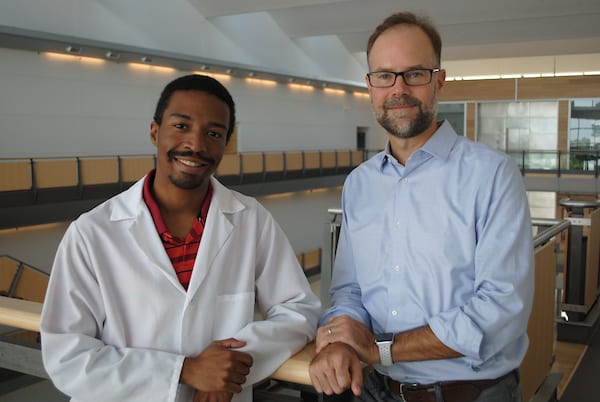“When I found out, I took off running across the lab.”
That’s how Kevin Cox, a postdoctoral associate at the Danforth Center, describes the moment he found out that he had received the Hanna H. Gray Fellowship from the Howard Hughes Medical Institute. “It was definitely emotional. I had applied to this same fellowship a year ago, made it to the final round but didn’t get it. I went into the process this year with the mentality that I was going to do better,” he explained.

The Hanna H. Gray Fellowship is a prestigious honor with the potential to catapult Kevin’s career as a plant scientist. The fellowship will support him for up to four years of postdoctoral training. Additionally, it will supply him up to four years of start-up funding in a faculty position anywhere in the U.S. “Coming into a faculty position with your own funding is huge. It would greatly increase my likelihood of getting a position,” explained Kevin. The fellowship specifically seeks out scientists from underrepresented groups that are early on in their career, with the hope that it will help ensure that they remain in the sciences.
By intentionally recruiting individuals from gender, racial, ethnic and other underrepresented groups, the Hanna H. Gray Fellows program is increasing diversity in the biomedical research community.
The need for more diversity in the sciences is a challenge that Kevin has experienced firsthand, and it’s one of the reasons that he regularly volunteers for our education programs teaching STEM concepts, like chemistry and phenotyping, to students in schools throughout the region. “I hope that I can be an example to young black American kids of someone who looks like them and is succeeding in the sciences. I hope that it inspires them and broadens their view about the type of career they could have,” explained Kevin. When Kevin was a young student himself, he had mentors that were critical to developing his career as a scientist. He credits his Ph.D. advisor at Texas A&M University, Libo Shan, as a mentor that helped keep him in the sciences. As a 22-year-old student, Kevin said he had very little experience independently developing experiments and critically analyzing data until he met Libo. She helped him build a strong foundation in the sciences. “She taught me everything I needed to know,” he says. He also credits Danforth Center Principal Investigators Blake Meyers, whose lab he currently works in, and Todd Mockler, whose lab he worked in for 18 months as an undergraduate lab assistant. As mentors, they made a powerful impact on his career.
“Kevin is a talented and creative early-career scientist, highly deserving of this prestigious award,” said Meyers. “During his post-doc, the work he does and the resulting discoveries will be exciting and impactful, fitting well with the mission of the Danforth Center. And this award will help launch him into a distinguished academic career. I’m thrilled for him and delighted to work with him to develop a powerful new technology and to apply it to understanding and combatting plant diseases.”

With the Hanna H. Gray fellowship, Kevin’s future as a plant scientist is brighter than ever. His background is in plant pathology, seeking to understand how plants get sick and why. The project he is working on through the fellowship will allow him to pin-point gene expressions during infection. Right now, plant scientists are looking at a bulk amount of genes. They know what genes are being expressed but not exactly where. Kevin compares it to a U.S. map without any state borders, highways or bodies of water to use as reference points. Through his fellowship project, he is going to research what specific genes are being expressed and where they are located within the plant. This will ultimately allow him to determine how plant cells and microbes communicate at a cellular level.
To do this, he will be collaborating with Kirk Czymmek, director of the Center’s Advanced Bioimaging Laboratory. They will be using a technology called spatial transcriptomics, a high-throughput gene expression technology. Spatial transcriptomics allow scientists to take a plant sample, put it on a glass slide with lots of uniquely barcoded DNA sequences, and capture all of the RNA from the plant sample. This will allow Kevin to sequence the genes and locate where and how much it is expressed in the plant. By working closely with Kirk and other collaborators on the imaging involved in this project, Kevin will gain microscopy skills in the process.
By identifying what key genes are involved in plant response to pathogens, Kevin’s research could ultimately speed the process to create plants that are resistant to diseases. “If we can find the key genes that are involved in resistance, we can develop plants to be more resistant to pathogens, eliminating crop loss and insuring more food for the world’s rapidly growing population,” he explains.
In the future, Kevin hopes to lead his own lab that focuses on plant-microbe interactions, where he can continue to study the mechanisms of disease susceptibility and resistance in order to develop plants that are resistant to a variety of diseases. He also wants to continue mentoring other students, “Keeping people in the sciences comes from strong mentoring at an early age. I want to help inspire the next generation of scientists that would come through my lab,” he says.
Congratulations Kevin!